
Member of E dible Communities No. 5 Spring 2023
Gratis
EAT. DRINK. THINK. LOCAL.


Advertise with Us! advertise@ediblergv.com | (956) 496-4920
26
20

28
30
32 Spicy Spring Smash

SPRING ISSUE 2 PUBLISHER’S NOTE 5 NOTABLE EDIBLES 6 WHAT’S IN SEASON March – May 8 GOING GREEN How to turn Organic Waste into Compost 11 COMMUNITY RGV Food Summit 14 HIGH-END RESTAURANTS FACE HEADWINDS POST-PANDEMIC 18 NATURE Flower Power 22 IN THE KITCHEN The Magic Valley Pantry 24 WELLNESS CSAs Benefit Farmers and Consumers
VALLEY NATIVE PLANTS
THE BEAUTY IN OUR
GUIDE
27 MARKET
32 LAST SIP RECIPES
Chamomile Cream Cupcakes
Strawberries
Nasturtiums
Cardamom
with
and
Minestrone Soup
Mussels
la Española
a
ON THE COVER Mango, Pineapple and Strawberry Spicy Spring Smash
SPONSORED CONTENT
Photo by Daniela Loera
Spring is springing … Are we ready?
Welcome to our first issue of 2023.
In our story by Denise Cathey, I loved learning about our local crop of edible flowers. I will definitely serve the cupcakes for dessert at my next dinner party, and I look forward to visiting the local flower markets to source a variety of these vibrant edibles. Spanish dagger sounds delicious and one I really need to get my hands on and try.
Subscriptions are all the rage. Would you sign up for one that would guarantee you farm fresh produce, knowing that it supports local farmers and grows your local food economy? It’s a no-brainer, right? Well, while this sector is in its infancy in the Rio Grande Valley, as our article by Chris Ardis notes, you may find a producer no matter where you live in the Valley. I find it curious that community-supported agriculture (CSA) does not resonate more with RGV consumers. Two CSA vendors. Sentli and Brownsville Wellness Coalition, have rebranded their CSA as a farm togo box and bag bundle and are having more luck selling their local produce. Read Chris’ story and learn more about CSA.

If you prefer to grow your own veggies, composting will be important to your success. While you can buy compost from some local vendors, you may also repurpose your waste into compost. Katie Lavallee gives us the lowdown on how to do this at home. It’s actually pretty easy. Beekeeper Glen Simpson provides an insider tip: If you are looking to plant a new fruit tree, place compost in the hole for the tree before you plant it. Just follow the instructions in the story.
Letty and I are honored to be working with Dr. Alexis Racelis of UTRGV by serving on its Food Services Advisory Committee. It has been amazing meeting the individuals who are trying to make the food economy more sustainable in the RGV. As part of their mission, they will host the first food summit in April. I am very excited to be moderating a panel with local chefs on our local food culture. I hope you can attend.
Our two recipes in this issue are easy to make. The mussels are always a crowd pleaser. While they look intimidating to prepare, they are not. An insider tip when eating mussels is to use an empty shell as tweezers to grasp and eat the rest. The minestrone soup, hearty, healthy and so flavorful, is a staple in our fridge now. If you make these dishes, share with us how they came out on our Instagram @edibleriograndevalley.
While reading Steve Clark’s story on the restaurant scene post pandemic, I could not help but have flashbacks to my days in the industry and be grateful that I am now only a guest. The restaurant industry is unrelenting, and now more than ever, any margin that existed pre-COVID is being eaten up by a new problem: rising costs. As we know, everything is getting more expensive. The only way for our favorite restaurants and bars to stay in business is for us to realize they too are affectd, and support them in the ways we can. Keep in mind how much we all love dining out, for the nourishment, social aspects and convenience. You don’t need to grocery shop, clean the ingredients, prepare the food, make sure it tastes good and wash the dishes. All you have to do is show up and eat! You can’t put a price on dining out, a good friend of mine says.

We are excited to share that Edible Rio Grande Valley won two gold awards, for Best Cover and Best of Print, from the American Advertising Federation’s Rio Grande Valley chapter. You may remember that the cover of our inaugural issue featured chile pequins. It was the work of photographer, Yvette Vela. We believe the image truly represented the food culture of the valley we call home. On behalf of the Edible team, it is an honor to receive such recognition from our peers.
As always, please share the magazine with friends and family and go out and support the businesses that are making it possible to bring it to. We couldn’t do it without our advertisers, so thank you to those who see the value in what we are doing!

I wish everyone a happy spring.
Jacqueline Folacci Publisher

2 SPRING 2023 edible RIO GRANDE VALLEY Edible Communities Publications of the Year (2011) PUBLISHER’S NOTE
is published quarterly by GC Publishing LLC. Subscription rate is $28 annually. No part of this publication may be used without written permission of the publisher. Every effort is made to avoid errors, misspellings and omissions. If however, an error comes to your attention, please accept our sincere apologies and notify us at hola@ediblergv.com. Thank you.
rights
©2023. All
reserved edibleriograndevalley.com







edibleriograndevalley.com 3







4 SPRING 2023 edible RIO GRANDE VALLEY The Valley's premier linen service. naturally fermented sustainable wines. Open Tue-Sat 11am -8pm. Online order for pick up only. Cheers! 1307 N. Main St., McAllen | 956-540-7342 docewineshop.com We offer a curated selection of classic reads and locally roasted coffee. And now featuring our own signature line of pastries from the Karma kitchen. 2500 Padre Blvd. South Padre Island 956-747-2568 edibleriograndevalley.com Never Miss An Issue Subscribe Today! Subscribe and have Edible Rio Grande Valley delivered to your door each season.
Las Ramblas of Brownsville and Ana Liz Taqueria in Mission are semi-finalists for 2023 James Beard Awards. Las Ramblas was nominated in the category of Outstanding Bar, and chef Ana Liz Pulido is competing in the category, Best Chef: Texas.
Considered among the most prestigious honors, the James Beard Awards recognize outstanding talent in the culinary arts and hospitality throughout the U.S. Winners will be celebrated at a ceremony on Monday, June 5 at the Lyric Opera of Chicago. Be sure to congratulate and support both these restaurants.
RGV Chefs Invited to Inaugural “Encuentro” on Comida Casera
Three chefs with strong ties to the Rio Grande Valley will participate in the first-ever “Encuentro: The Native American Roots of Texas Mexican Food” in Houston, May 19 and 20.
They are former Brownsville native, Sylvia Casares, chef and owner of two Sylvia’s Enchilada Kitchen restaurants; Nadia Casaperalta, chef and culinary instructor at South Texas College in McAllen; and Larry Delgado, owner and chef of award-winning restaurants SALT, Salome and house.wine.bistro in McAllen. The two-day conference will focus on cooking comida casera, the home-style cooking of Native Texan Mexican American families.
“Complex and also straightforward are words that aptly describe comida casera, which includes the dishes of moms, abuelitas,
aunts and uncles that families in the RGV have enjoyed over the past 500 years,” says Adán Medrano, chef specializing in Indigenous foods of Texas, author and president of The Texas Indigenous Food Project, the organization behind Encuentro.
During the event, the invited chefs will cook one of their specialty dishes and interact with scholars in the fields of anthropology, archaeology, history and Mexican American studies. Encuentro will document and explore the impact, native history and unique flavor profile of Texas Mexican food. The public is invited to the media and scholar/ chef panel on the evening of May 20. Visit texasindigenousfood.org/encuentro for information.
Former RGV Journalist Tells Story of Migrant Farmworker Becoming a Chef
The Migrant Chef: The Life and Times of Lalo García offers an unforgettable window into a family’s border-eclipsing dreams, Mexico’s culinary heritage and the making of a chef. The author, Laura Tillman, former reporter for The Brownsville Herald and now based in Mexico City, spent five years reporting on Eduardo “Lalo” García Guzmán, following him from his acclaimed restaurant Máximo Bistrot in Mexico City to the onion fields of Vidalia, Ga., to Dubai’s first highend Mexican restaurant and to Lalo’s hometown of San José de las Pilas.
“I’ve learned so much from Lalo in the process of reporting this story — about family, food and the artistic process. I think readers in the Rio Grande Valley will connect with many of the themes of his life, including migration and the history of the Bracero Program,” says Tillman.
Book reading events in the RGV are planned for later this year. Visit wwnorton.com/ books/9781324005773 to purchase The Migrant Chef.

Former Brownsville Residents Featured in Garden & Gun
Garden & Gun, a magazine that celebrates the best in Southern food, style, travel, music, art, literature and sporting culture, featured two former Brownsville residents in its February/March issue.
Chuck Charnichart and Alexis Tovias Morales are getting ready to open “what may well be one of the most important restaurants in Texas, a women-owned and -operated, South Texas-inspired barbecue joint called Barbs B-Q.” They hope to debut their eatery in Lockhart later this year. Read their story at gardenandgun.com.
Notable Openings: Throughout the Rio Grande Valley
Brownsville
Nolita NY Pizza
915 E. Elizabeth St.
Pluton Brewing Co.
805 E. Elizabeth St.
Edinburg
Castlehill Bistro
2113 W. Trenton Road
San Benito
Healthy Hut Kitchen
30747 E. Expressway 83, Suites E & F
South Padre Island
Nautico Island Grill
1313 Padre Blvd.
NOTABLE EDIBLES
Congratulations!
What’s In Season
March – May
What to Harvest
What to Plant
Beans
Beets **
Bell Peppers ***
Broccoli **
Cabbage **
Cantaloupes ***
Carrots
Celery
Cucumbers **
Field Peas **
Grapefruits **
Green Cabbage
Green Onions **
Greens **
Honeydew ***
Kohlrabi
Lettuce
Melons ***
Mushrooms
Onions
Oranges **
Potatoes
Snap Peas
Spinach *
Squash
Sweet Peppers ***
Tomatoes
Turnips
Watermelons ***
Zucchini
Corn *
Cucumbers *
Eggplant *
Honeydew
Hot Peppers *
Lima Beans *
Okra

Peas
Pumpkins
Snap Peas *
Summer Squash
Sweet Peppers *
Sweet Potatoes
Tomatoes *
Watermelons
Winter Squash
March Only * March & April ** May Only ***
6 SPRING 2023 edible RIO GRANDE VALLEY










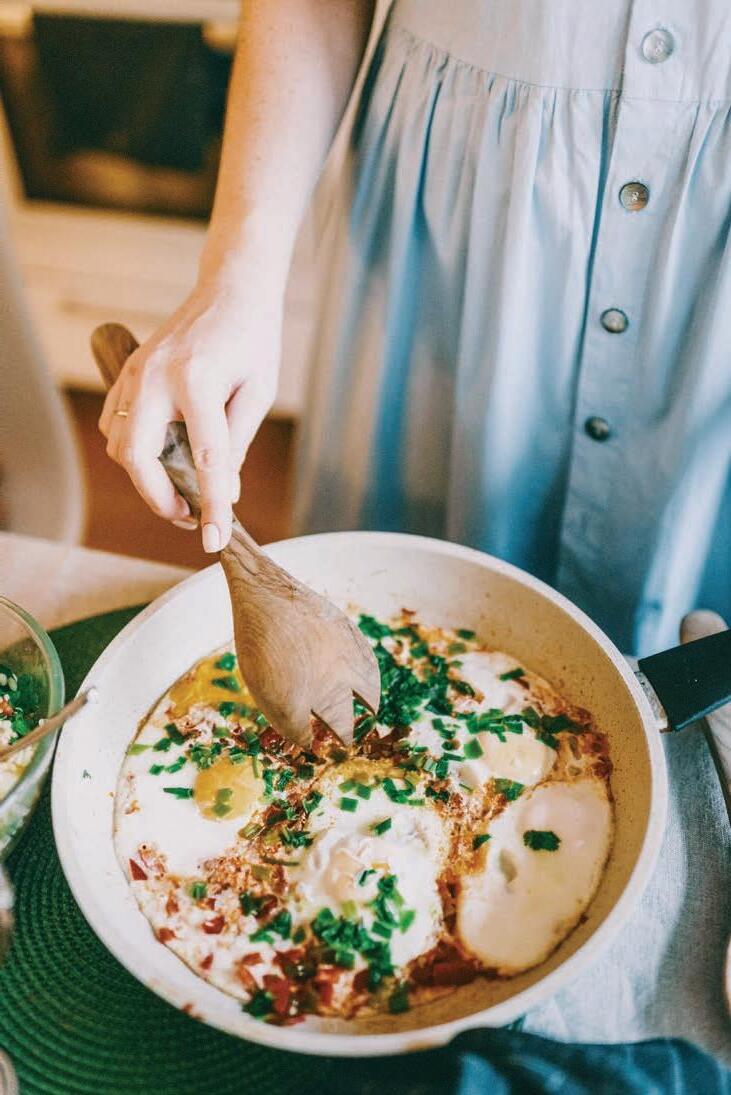


edibleriograndevalley.com 7 3381 E. Ruben Torres Blvd, Brownsville TX 920 N MAIN ST SUITE 160, MCALLEN, TX (956) 627 0594 @BONHOMIAONMAIN DISPOSE OF FATS, OILS AND GREASE PROPERLY. SAVE YOUR PIPES. 1425 Robinhood Drive, Brownsville, Texas 78521 www.brownsville-pub.com | 956-983-6100
HOW TO TURN YOUR ORGANIC WASTE INTO COMPOST
THIS BENEFICIAL PROCESS STARTS IN THE KITCHEN.
STORY BY KATIE LAVALLEE | ILLUSTRATIONS BY SARA ORTIZ
Composting really is a win-win for the composter and the environment. It creates an organic material that can be applied to soil, gardens, trees and plants, reducing the need for chemical fertilizers. It keeps produce scraps, newspapers and other materials out of landfills. This reduces methane emissions in these areas of waste, which is significant given they are the third largest source of the greenhouse gas, according to the Environmental Protection Agency.
These outcomes all sound great, but what is involved, you might ask. We break it down for you here (no pun intended).
Compost requires three components to work: “greens,” which provide nitrogen; “browns,” which provide carbon; and water, which provides moisture. Over time, the combination encourages the beneficial bacteria and fungi to grow, and they decompose the organic matter into humus, a nutrient-rich material.
Greens


include peels and bits of fruits and vegetables (no fruit pits), eggshells, coffee grounds, tea leaves, paper tea bags and coffee filters, nut shells and grass clippings.
Browns
include shredded newspaper, cardboard and paper, dead leaves, branches and twigs.

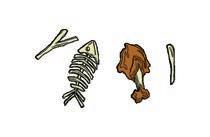

HOW TO GET STARTED
Follow these steps, and you’ll be well on your composting way.


1 Choose a designated container, like a plastic bucket or coffee can, for green materials generated as you cook. As you come across them, add them to the container. It’s easiest to keep the container on a countertop, but if space is limited or the scraps attract pests, try storing it in the freezer.
2 Decide whether to compost inside or outside your home. Select another container or a confined, dry, shady space in your yard for your pile where decomposition will occur, anything from a 5-gallon pail to a 5-by-5-foot enclosure. You can always buy a composting bin.

3 Gather brown items and about as much greens as you have collected.

4 In your chosen space, layer, in an equal amount, browns on the bottom, greens on the top. Within your green layers, alternate between smaller and larger pieces. Add moisture to your brown layers. Over time, as you collect greens and browns, add equal layers to your compost pile. If possible, keep it covered, with a lid or tarp, to retain moisture. During summertime, you will need to add extra water to your pile. Consider using water from cooking pasta or other excess water to do so.
Dmeat or fish bones and scraps; dairy products, including butter, milk, sour cream, yogurt and eggs; fats, grease, lard and oils; and yard trimmings treated with chemical pesticides.
5 Decide how much more effort you want to put into composting. If you do not want to do anything more than continue adding layers, your system will be a passive one and will take longer to decompose than an active system.

SPRING 2023 RIO GRANDE VALLEY
GOING GREEN
Tips
AN ACTIVE SYSTEM NEEDS YOU TO ROUTINELY MIX OR TURN THE PILE, using a shovel or pitch fork or, like urban farmer, Stephanie Kasper, rely on feathered friends.
“We don’t turn very often, maybe every two to three months, but the chickens do scratch through it to find interesting morsels and bugs. So [it’s] slightly chicken turned,” she says.
IF YOU WANT TO TAKE COMPOSTING TO THE NEXT LEVEL, consider adding earthworms — Bequita’s Blooms & Botanicals in Harlingen sells them — which help break down the material into smaller pieces.



A USABLE PRODUCT AT LAST
It can take anywhere from two weeks to two years for your compost to become ready for use, depending on the size of the pile, how often you turn it and other factors. When the material at the bottom of your pile is dark and rich in color, you may use it to enrich your gardens, trees and plants.


COMPOST PULLS CARBON FROM THE ATMOSPHERE INTO SOIL and stimulates the microbes contained within it. The result is an improved soil structure. Compost helps soil retain moisture, too, which is vital during droughts. With plants and trees, compost reduces the incidence of diseases and pests, helping keep them healthy and growing.


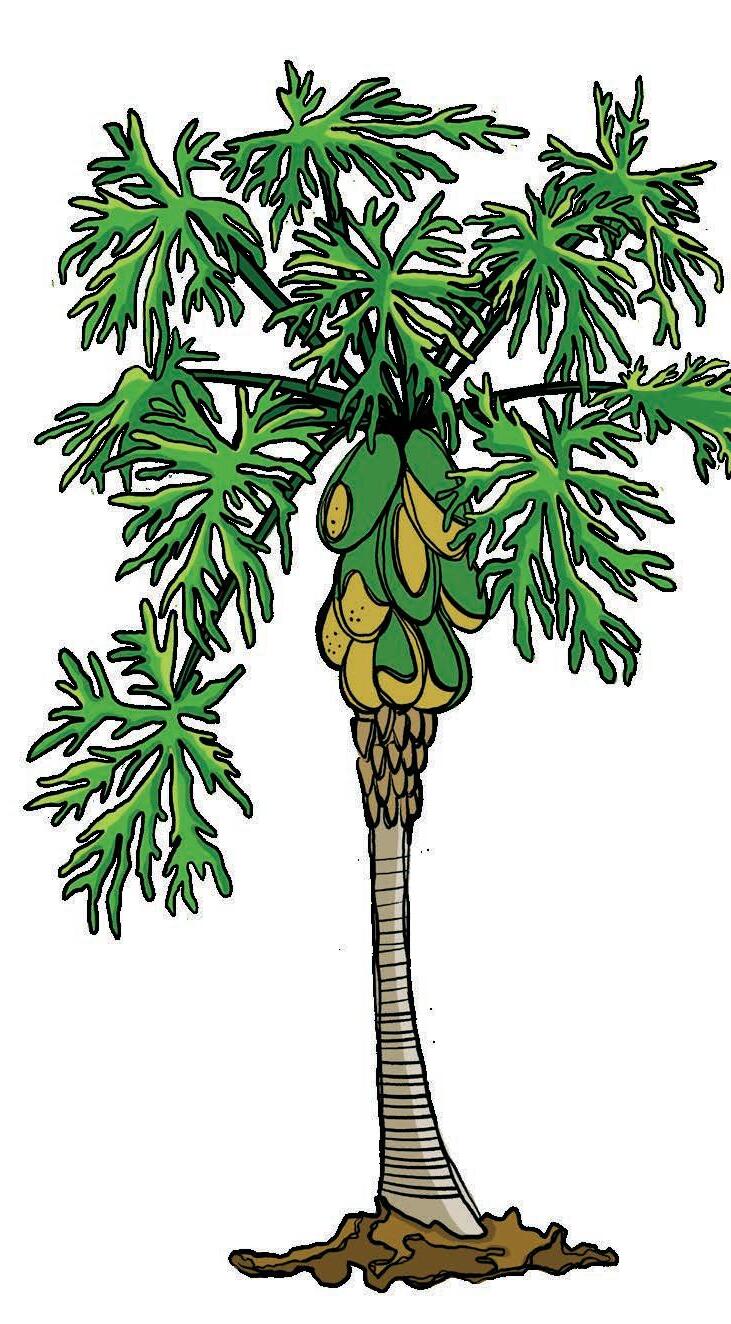
For more information on composting, visit txmg.org/cameron/education/composting.

Katie Lavallee is the education coordinator with the Texas Center for Local Food. She is a passionate environmental advocate and gardener striving for a zero-waste lifestyle.

edibleriograndevalley.com 9
IF YOU HAVE ANY FLORA IN YOUR YARD OR GROW PRODUCE, CONSIDER STARTING TO COMPOST TO REAP THE MANY PERSONAL AND ENVIRONMENTAL REWARDS.
Mitte in Motion: A Dynamic Arts Festival

Saturday April, 29 | 9:00-4:00 PM in the Mitte Cultural District


Workshop series with talent from Hollywood, California in the Film Industry
MJ Dougherti - Writer/Author
Jordan Ancel - Film Producer/Director
Brianna Ancel - Talent Scout Agency
David Wells - Acting
Irene Salazar - Voice and Opera
Nik Tizekker - Cameraman and Producer
Bitsy Harris - Artist
mitteculturaldistrict.org
instagram: @mitteculturaldistrict facebook.com/MitteCulturalDistrict
10 SPRING 2023 edible RIO GRANDE VALLEY
RGV Food Summit
To Celebrate Food Culture and Agricultural History
STORY AND PHOTOS BY STEPHANIE KASPER
The history of food and agriculture in the Rio Grande Valley is as rich in productivity and culture as it is packed with contradictions.
How is the same region that produces more fruits and vegetables than any other area in Texas also one of the state’s hungriest communities?
Who benefits from the nutritious foods grown from our soils by our farmworkers, if not our people, who have some of the highest rates of diet-related chronic conditions in the country?
What would a food system in the Valley look like that is more just, equitable and sustainable for all?


Energy and effort to address these questions are bubbling throughout the region. Small farms are emerging. Organizations like the Sentli Center for Regenerative Agriculture in Edinburg, HOPE for Small Farm Sustainability in Harlingen, the Brownsville Wellness Coalition and the University of Texas Rio Grande Valley (UTRGV) all are training people in the art, science and business of sustainable food production. School districts like Mission and Pharr-San Juan-Alamo
along with IDEA Public Schools are adding sustainable agriculture production and content to their campuses and curriculum.
This movement has deep roots in the history of agricultural resistance in the Valley, from the 1966 Starr County melon strike and 1979 Raymondville onion strike to ongoing farmworker organizing and initiatives by La Unión Del Pueblo Entero (LUPE) today.
Each of these agricultural actors has a vision of a just Valley food system they are working to bring to fruition. The wisdom is already here in our community though sometimes slowed by our isolated efforts and hindered by bureaucratic obstacles.
To help sidestep these obstacles, with funding from the W.K. Kellogg Foundation, Dr. Alexis Racelis, program director of UTRGV’s Agroecology Program, and Hernán Colmenero, founder and CEO of the Institute for Ecology, Scholarship, and Health, have formed an Equitable Food Systems Advisory Committee. This committee of diverse community stakeholders has a Food Summit planned to celebrate food culture and agricultural history in the
Tomato tasting at Hub for Prosperity
edibleriograndevalley.com 11
COMMUNITY
Valley and imagine pathways forward to a food system that serves all.
The Food Summit, hosted by UTRGV’s Agroecology Program and Office of Sustainability, will take place during UTRGV’s annual Earth Fest, April 17 to 21, 2023. Events will be held at the Edinburg and Brownsville campuses, with in-person and virtual options for participants.

Activities will include movie screenings, presentations from food visionaries and conversations about food justice, institutional food procurement, local agricultural history, economic prosperity and other related topics.

“We want to leverage the wealth around food culture and agriculture in our community through this summit, and bring together diverse ideas and expertise around prosperity for our community,” Racelis says. “Ultimately, these conversations will help inform and develop a Rio Grande Valley Food Charter, a guiding document that will state common goals and shared values for our regional food system.”
Racelis says agriculture and food are key elements of Valley identity. “We know that these conversations are painful at times and have not been inclusive of diverse voices or discussed in a public way,” he adds. “This food summit aims for an open, inclusive and transparent goal-setting process that brings farmers, food distributors, educators, academics, activists, artists and consumers together with policymakers
and government agencies that can provide follow-through for a shared vision.”
Event organizer Colmenero says the Valley has many assets that give it the potential for a strong, resilient food system that benefits all. “Our region has strong agricultural productivity and cultural legacy,” he says. “But there is a gap between production and our community that leads to public health problems, economic disparities and environmental issues.”
Among these difficulties, the RGV experiences high rates of diet-related diabetes and heart disease, family farmers who struggle to compete against the efficiencies of large corporations and continued loss of Native and agricultural lands to urban expansion.
“The food summit conversations can be a catalyst to bring stakeholders together, elevating our already strong food culture and moving forward with intention to address issues of equity around food,” says Colmenero.
More details about the Food Summit, schedule and locations are available at rgvagroecology.com.
• Hosted by UTRGV’s Agroecology Program and Office of Sustainability
• Make sure your voice, expertise and wisdom are included in this collective vision for the future of our region’s food system.
• Mark your calendars for April 17 to 21, and join the festivities. Visit rgvagroecology.com.
12 SPRING 2023 edible RIO GRANDE VALLEY
Stephanie Kasper is the program manager at the University of Texas Rio Grande Valley’s Hub of Prosperity and a proud front yard vegetable grower.
Food Summit
“The food summit conversations can be a catalyst to bring stakeholders together, elevating our already strong food culture and moving forward with intention to address issues of equity around food.”

HIGH-END RESTAURANTS FACE HEADWINDS POST-PANDEMIC
STORY BY STEVE CLARK | PHOTOS BY MICHAEL GONZALEZ
Operating a high-end restaurant successfully, much less three of them, is always a complex proposition, but it was a whole lot easier before the pandemic.
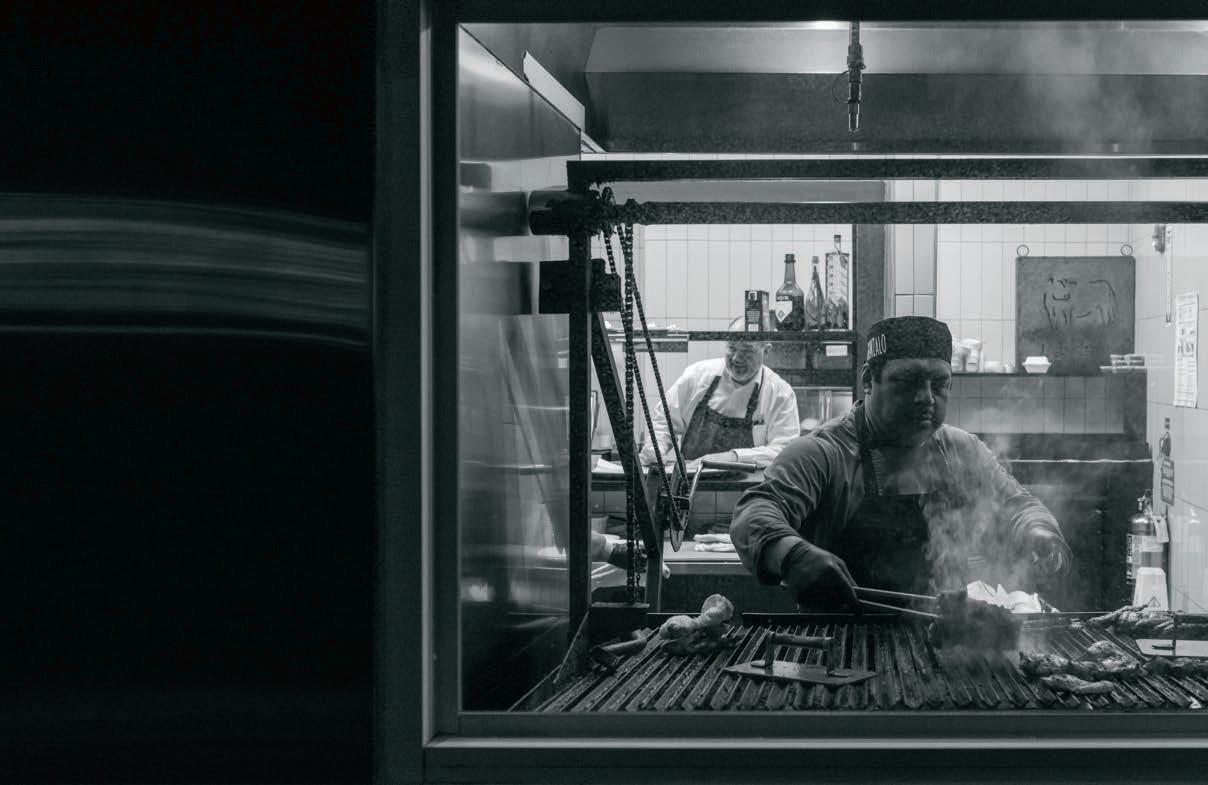
Ask chef Larry Delgado, whose McAllen-based Delgado Collective is made up of house.wine.&bistro., SALT and Salomé on Main, which he and his wife, Jessica, opened in 2008, 2013 and 2019, respectively. While COVID appears to be with us for good, quasi-normalcy has returned to many corners of daily life, but restaurants like the Delgados’ are still facing headwinds that largely weren’t a factor before the pandemic.
LARRY REMEMBERS THOSE DAYS WITH FONDNESS.
“It was great,” he says. “Business was fantastic. We were looking in Brownsville as a matter of fact. We were looking at Corpus Christi, and we kind of toyed with the notion of Austin or San Antonio. Pre-pandemic, business was pumping on all cylinders and we were looking for a way to scale our restaurants to expand.”
Enter the pandemic, shutdown and “survival mode” for the Delgado Collective. The situation demanded nimble adaptability. The Delgados, like so many other restaurant owners, got into the delivery business, setting up their own system rather than paying what the third-party delivery companies were asking. The company has also leaned much more heavily into catering as delivery has tapered off, Delgado says.
Supply chain issues and skyrocketing prices for food have forced some items off the menu, he says. The tuna from Honolulu Fish Co. first became hard to get. Now if it’s available, it’s unaffordable, Delgado says.
“Where we used to get free shipping, now we might have to pay a couple hundred dollars in shipping, and now I can’t offer a beautiful filet of ahi tuna or sashimi or Japanese sea bass,” he says. “I can’t do it for $35 anymore. I can’t even do it for $45. I have to sell it for $70.”
14 SPRING 2023 edible RIO GRANDE VALLEY

BEEF, SAME STORY.
“Beef came down to a manageable price and last week [went] right back up to $17.99 for ribeye,” Delgado says. “That’s double what it was pre-pandemic. We used to pay $9.99.”
Staffing is another headache. The Delgados are down to fewer than 90 from a peak of 145 across all three restaurants. These issues barely scratch the surface, though Delgado is loath to sound like a complainer. McAllen has been very good to his business over the years, he says, and for that he’s exceptionally grateful. At the same time, he’s hoping for a little understanding from customers who might balk at higher menu prices or extra credit card fees, none of which comes close to covering losses he’s experiencing.
On the bright side, the Delgados were coming off a terrific fourth quarter of 2022 after a “miserable year,” and Delgado had his fingers crossed for more of the same for the first quarter of this year.
Chef Adam Cavazos, who opened Bodega Tavern & Kitchen in McAllen seven years ago in November, originally aspired to a Delgado Collective-caliber experience, but ended up modifying his concept. The Mercado District was Bodega’s first home, and Cavazos says he’s grateful for the experience even if it didn’t pan out.

“We had lots of things on our menu that were what I was considering sort of more pushing the Valley’s culinary scene forward,” he says. “But the pandemic really changed all of that. We had to fight for survival during the closure.”
Bodega’s pivot to a less exclusive but nonetheless chef-driven concept has worked out well, Cavazos says. But he’s grappling with higher costs along with everyone else. It’s meant changes to the menu and substituting
products when something gets too expensive or hard to come by.
“There’s a couple of things I pride myself on, and one of those things is finding lower priced items that are just as good in quality and dressing them up,” Cavazos says. “It’s how you treat the product, is my philosophy.”
He’d like to maintain Bodega’s reputation for being reasonably priced if higher end, though it’s hard to know how to handle ribeye going up from $12.99 to $19.99 a pound, especially since New York Strip was already on his menu, Cavazos says.
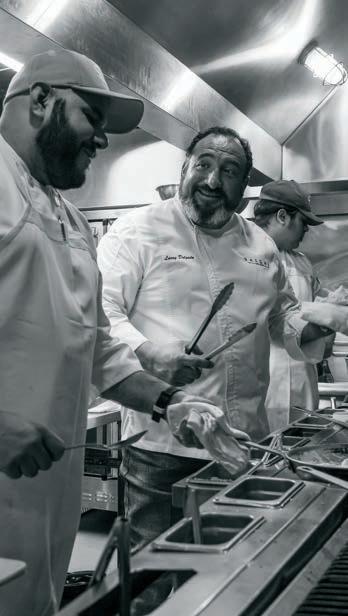
TERES MAJOR RIDES TO THE RESCUE.
“They call it the hanging tender,” Cavazos says. “It’s a tender that comes from the shoulder clod and it’s about maybe a foot long. Basically we made little steak medallions, and that was our other steak option. We sous vided it and we served it with the leak purée and the red wine jus. In other words, for us it was all about getting creative and finding ... items that had the quality but that were cheaper and that we could do them in our style, if you will.”
Rafael Lopez’s family has been riding the hospitality industry roller coaster since his grandparents ran a one-stop bar, restaurant, store, bus stop, barber shop, hotel and party venue in the center of their tiny village in northern Spain. Lopez and his brother Jose Antonio and sister Alicia opened La Pampa Argentinian Steak House in Brownsville in 2004 and Madeira, also in Brownsville, in 2011, after having success with the same concept in Toluca, Mexico.
La Pampa reopened in a new location (on Pablo Kisel Boulevard) only a few months before the pandemic arrived in the Rio Grande Valley. The family was on the verge of opening Antíca Gastrobar, a new watering hole next door to La Pampa, but then came the big shutdown. Madeira and La Pampa were eligible for forgivable loans through the federal Paycheck Protection Program (PPP) since their employees had been receiving paychecks, but Antica hadn’t yet cut its first payroll check much less sold its first beer, and thus was ineligible.
“We had everything to open Antíca,” Lopez says. “We even had the servers, the bartenders, the bar backs, the chef — everything all ready to go, but we couldn’t open.”
La Pampa and Madeira found themselves in the takeout business, something the family was not prepared for, since the fare

16 SPRING 2023 edible RIO GRANDE VALLEY
they’re famous for generally doesn’t travel well — especially steak.
“You take it to your home and it’s going to be cold,” Lopez says. “What are you going to do with it? Put it in the oven? You are killing the food.”
Still, it was a way to keep tips flowing to their servers at a time before PPP was announced. The family was determined to hang on to their valuable employees and succeeded for the most part.
“We wanted to keep the servers and the kitchen staff,” Lopez says. “After so many years your staff, well, it’s the most important part of any business. … We did the same at Madeira. We tried to sell food to go and we changed our menus to do it simpler, less expensive. But basically we didn’t make any money.”
Business came roaring back after restaurants were allowed to reopen and people had federal COVID-assistance money burning a hole in their pockets and a profound wish to get out of the house, he says.
“When the money started coming in, the restaurants went up like crazy, like the best sales in years,” Lopez says.


Fast forward a year to early February and things are “not perfect,” he concedes. Customers are still coming in but spending a little less extravagantly, toning down the celebrations a notch or two. Some who used to come twice a week maybe are only coming once a week. The last two weeks of January were unusually slow and Lopez’s suppliers were warning of coming beef price hikes, while some products sometimes become impossible to get.
“It’s not as consistent as before, and that’s something that we have to understand,” Lopez says.
Despite the obstacles, he believes the worst of the pandemic is over and that — barring a catastrophe — the restaurants can survive pretty much anything the next two decades throw at them. If not for the financial help, however, including assistance from the city of Brownsville, it might have been a been a grimmer outcome, Lopez says, expressing gratitude for “how the government managed things.”
“Without the help from the government, we couldn’t have done it,” he says. “Probably none of it would have survived. It would have been a struggle to survive.”
edibleriograndevalley.com 17
Steve Clark is a reporter living in Brownsville. In his spare time, he enjoys playing banjo and guitar, canoeing with his lovely wife Laura and eating and writing about great food.
Left: Chef Adam from Bodega Tavern & Kitchen plating a dish.
Bottom: Chef Larry works hand in hand with his team at Salt.
Right: Dining room at La Pampa
STORY AND PHOTOS BY DENISE CATHEY
The buzz of honeybees is in the air. Cool breezes off the coast waft through your hair. Days start and end with sunlight.
Spring is a heady time here, with all sorts of locally grown produce available to fill your kitchen table. However, there is one product that you might not have ever considered eating — flowers.
So in spring, let us leap into the proverbial flower garden together. There is more here than you might think.
EDIBLE FLOWERS?
Before you raid your garden for goodies, be aware that not all flowers are edible. Edible flowers can be consumed, either the whole flower head or the petals, but they must be free of pesticides and other chemicals that are unsafe for ingestion.
Popular flowers that do double duty in bouquets and on the plate this season are: marigolds, calendulas, nasturtiums, johnny jump ups, rose-scented geraniums, bachelor buttons, bee balms, cosmos, zinnias, mammoth sunflowers, roses and some varieties of hibiscus.
Flower grower Rebecca Rodriguez, of Bequita’s Blooms & Botanicals in Harlingen, enjoys bright orange marigolds on salads as a garnish or in cold margaritas on the rocks.

“I like marigolds. They are very fragrant, and they have almost a peppery spice to them,” she says.
For kitchen-produce gardeners, some of the plants you already grow often create edible flowers.

Zucchini, tatume squash, borage, broccoli, coriander, cilantro, garlic and onion chives, arugula and cucumber all produce flowers with unique tastes.
According to David Vasquez, the program manager of urban farms and community gardens at the Brownsville Wellness Coalition, cucumber blossoms are a treat that tastes like cucumbers.
“It is almost a delicacy because you have to catch it early,” he says, because of their short life.
Along with edibles in your garden, the Valley has a few native plants that you can enjoy if you know where to look for them, says Bianca Banda, a park ranger interpreter at Bentsen-Rio Grande Valley State Park in Mission. Every month, Banda leads programs and walking tours to help visitors experience the park and nature in new ways, including through taste.
Fans of the drink agua de Jamaica, made from hibiscus, will be pleased to know that the Valley has a native alternative to hibiscus with a similar taste, Banda says.
“Here we have something very closely related that you can do the
same thing [with], called Turk’s cap,” she says.
The red flower mimics the look of an unopened hibiscus, which flowers year-round, but especially in summer.
The most famous of our native edible flowers, however, is the Spanish dagger, a species of yucca that flowers only once or twice a year between April and early August. The flowers, considered a delicacy, have the flavor and texture of sweet onion.
Traditionally these are eaten either opened or unopened, but if the flower has bloomed, just the petals should be consumed, not the entire flower. Usually, they are the breakfast companion of eggs and served with either tomatoes or salsa.
GROW YOUR OWN
If you have the itch to create an edible flower garden, several plants are a cinch to grow, even for the most hopelessly black-thumbed among us.
Farmer Dave recommends planting chamomile, cilantro, zinnias, borages, marigolds and/or nasturtiums to start.
All of these plants require about 55 to 80 days to yield usable flowers, so there is plenty of time to enjoy them before the summer heat sets in. Just be sure not to spray them with pesticides, otherwise, they will not be safe to eat.
Denise Cathey is a reporter and photojournalist living in Brownsville. A native Texan, she has an ingrained love of whiskey, BBQ and the truly odd. Currently, she’s on a quest for the ultimate al pastor. Follow her on Instagram @denisecatheyphoto.
SUPPORT YOUR LOCAL FLOWER FARM
If gardening is not your , say, cup of edible flower tea, you may purchase edible flowers from these local flower farmers:
Acres of Harmony Flower Farm
At the Brownsville Farmers’ Market or by phone at (956) 245-9989
Brownsville Wellness Coalition
At the Brownsville Farmers’ Market
Bequita’s Blooms & Botanicals
At 15516 Hwy. 107, Harlingen Fridays, 9AM-6PM, Saturdays, 10AM-4PM or by phone at (956) 320-8575
Wild August Nursery & Flower Farm
To inquire call (956) 535-2117 or email: Flowers@wildaugust.com
18 SPRING 2023 edible RIO GRANDE VALLEY NATURE
Clockwise: Edible calendula flowers at Bequita’s Blooms & Botanicals in Harlingen; Owner Rebecca Rodriguez holds a bouquet of edible marigolds and cosmos flowers at Bequita’s Blooms & Botanicals in Harlingen; Edible cosmos flowers at Bequita’s Blooms & Botanicals in Harlingen; Texas Master Gardener Debbie Cox holds an edible calendula flower growing in her Brownsville garden.

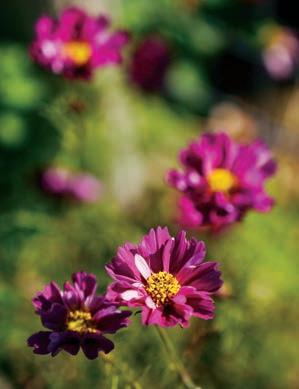


Cardamom Chamomile Cream Cupcakes with Strawberries and Nasturtiums
Recipe By Denise Cathey Makes about 30 cupcakes
For the cupcakes:
3 cups (345 grams) cake flour
5 teaspoons (20 grams) baking powder
½ teaspoon (3 grams) salt
1 cup (227 grams) unsalted butter, softened
2 cups (402 grams) granulated sugar
4 eggs
1 teaspoon (4.9 milliliters) vanilla extract
1 tablespoon (28 grams) cardamom
1¼ cups (296.2 milliliters) milk
The night before you make the cupcakes, infuse the milk with chamomile for the chamomile cream (see recipe that follows). In a medium saucepan on medium heat, bring the milk and chamomile flowers to a gentle simmer for 10 minutes. Then cover with a lid or place plastic wrap on the surface to prevent a skin and refrigerate overnight.
To make the cupcakes, preheat the oven to 350° F. Grease your cupcake cups or pan. Sift the cake flour, salt and baking powder
into a medium-size bowl. In a large bowl and using an electric mixer, cream the butter. Gradually add the granulated sugar and beat until the mixture appears light and fluffy. Be sure to scrape down the sides of the bowl.
Add the eggs 1 at a time, beating to incorporate each addition. Then add the vanilla and cardamom.
Alternate adding the milk and flour mixture, incorporating each addition.
Fill each cup in your pan with 2 tablespoons of mixture (or until cups are ¾ full).
Bake for 19 to 24 minutes, or until cupcakes appear golden and a tester inserted into the center comes out clean.
Remove the cupcakes from the pan and place them on a rack to finish cooling completely. While cooling, make the chamomile cream filling.
For the chamomile cream filling:
⅓ cup (67 grams) granulated sugar
2 tablespoons (18.7 grams) cornstarch
2 egg yolks
2 cups (473.2 milliliters) milk
2 teaspoons (9.8 milliliters) vanilla extract
3 tablespoons (9 grams) dried chamomile flowers
Mix the granulated sugar with the cornstarch in a medium-size saucepan.
Strain the milk and chamomile mixture to remove the chamomile flowers into a bowl. Whisk the egg yolks into the milkchamomile mixture.
Whisk the mixture into the pan containing the sugar and cornstarch. Cook over medium heat, stirring constantly until it thickens.
Once the mixture thickens, allow it to come to a boil for 1 minute. Remove from heat.
Once the cupcakes are cool, take a knife or apple corer and remove a small section from the center of each cupcake to a depth of ¾ of the cupcake. Insert 3 to 4 pieces of chopped strawberry in the hole of each cupcake’s center, at the bottom. Fill the remaining space with the chamomile cream.
For the whipped cream frosting:
3 cups (709.77 milliliters) heavy cream
2 teaspoons (9.8 milliliters) vanilla extract
6 tablespoons (46.9 grams) powdered sugar
1 cup strawberries, finely chopped Nasturtium blossoms, pesticide free, for garnish
In a chilled metal bowl, beat together the heavy cream and vanilla at high speed until the mixture begins to hold its own shape. Gradually add the powdered sugar and beat until the mixture forms stiff peaks.
Place the frosting in a piping bag or use a frosting knife and frost each cupcake. Garnish each with nasturtium blossoms. Refrigerate until serving. These cupcakes are best eaten in the first 2 days they are made.


20 SPRING 2023 edible RIO GRANDE VALLEY
all Americans. farmland.org

Discrimination against marginalized groups in agriculture negatively affects all Americans by limiting the opportunities for farmers, workers, and consumers. AFT is raising up diverse voices in agriculture, because we believe diversity contributes to a more resilient agricultural system, a stronger economy, and a more equitable society.

edibleriograndevalley.com 21
Get fresh updates on our work to ensure the future of agriculture includes
At American Farmland Trust, we believe agriculture is strengthened through diversity.
AL CHILE SALSA
The Magic Valley Pantry
STORY BY NOELLE BRESSON
APPLE CIDER VINEGAR HAND SOAP
Thanks to ButterFaye Organics, we can kiss kitchen germs goodbye with Cash Casia’s Apple Cider Vinegar Hand Soap.
Made with all organic, farm grown lemon, bergamot and sage essential oils, this handmade soap is antibacterial, antifungal and antiseptic. It’s perfect to reach for after handling raw meat or working in the yard. While apple cider vinegar can be harsh, this soap also contains coconut, avocado, olive and castor oils as a base to keep your hands soft after each use.
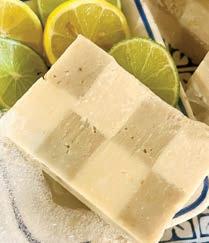
ButterFaye Organics is a side project by alternative medicine guru Cash Casia, who started making home remedies to complement her homeopathy practice during the pandemic. She says her product line started “completely by accident.”
“I took a few hundred bars of soap to the farmers’ market and sold out the same day,” says Casia. “ It’s fun because I get to be creative and combine my knowledge of pre-med chemistry and herbs.”
She’s expanded her product line to include luxury organic skin care, insect repellent and healing syrup products. You can find her merchandise at various farmers’ markets throughout the Rio Grande Valley.
While experimenting in the kitchen, Tom Dunn of Brownsville created the recipe that we know as Al Chile Salsa.
“We had invited some friends over, offered them some of Tom’s salsa. From that point on, everyone asked us to bring our salsa to parties,” says Tom’s wife Claudia.
Friends and family encouraged the Dunns to take the salsa to the next level, selling it to local stores, but they were very busy raising their young children. Claudia says, “It seemed unreachable.”
That all changed in 2021, though, when Claudia debuted Al Chile Salsa on Instagram. After posting a picture of their homemade family salsa, just like that her phone pinged over and over with notifications of rave reviews, including “riquisima” (delicious) and “once you start dipping, you can’t stop eating.”
Locally sourced, the salsa contains natural tomatoes, tomatillos, onions, peppers, garlic and a unique blend of spices and is made with “pride and honor” in Brownsville.
Al Chile Salsa is perfect by itself with tortilla chips or for adding flavor to your recipes at home.
Many local restaurants and stores in Brownsville carry the salsa, and you may also purchase it online at alchilesalsa.com.

Visit butterfaye.com for locations and product info.

22 SPRING 2023 edible RIO GRANDE VALLEY IN THE KITCHEN
SEASIDE WOOD CO. MORTAR AND PESTLE
Ivan Benavides, local artist, owner and “wood turner” at Seaside Wood Co. has created a mortar and pestle that looks like a work of art. Benavides makes all of his products out of Texas timber found in the landscape around us here in the Rio Grande Valley.
In 2017, Ivan, a former professional photographer, was looking for a new art form to try and decided on wood turning.
“My wife and I would drive around just to see what we could find. At first I kept picking up driftwood, but I soon learned that driftwood didn’t work.” Now, instead, Benavides takes pride in using Texas native trees such as mesquite, fresno and ebony. “All of my pieces start off as a log. In that way, each creation is unique.”
You can use his beautiful mortar and pestles to grind spices and make salsa, sauces, guacamole — the options are endless.

Check out his other creations on Instagram @seasidewoodco or on Facebook.
I LOVE CHAMOY
Annie Leal admits she wasn’t looking to get into the food business but her calling came shortly after her father was diagnosed with diabetes.
“My dad had his own drawer of sugar free candy filled with all sorts of sweets and chocolate, but there was no sugar free Mexican candy [available].”
This surprised her, as the family originated from Monterrey, Mexico and often had spicy and sweet treats on hand. Chamoy was always a staple in their home.
Leal wanted to create a chamoy that her dad and others trying to limit their sugar intake could enjoy and love. It took her six months of testing recipes and ingredients to develop a formula that her family approved. The result is a sugar- and carb-free candy sauce made with a special blend of spices, lime powder, monk fruit and hibiscus for the bright color.
Using her background in social media and marketing, Leal launched I Love Chamoy in 2021. Since then, the business has been an “incredible experience,” she says.

In 2022, I Love Chamoy was named the grand prize winner in the H-E-B Quest for Texas Best, a huge accomplishment for the McAllen native.
Now, Leal is working on expanding the I Love Chamoy line with new flavors. “Stay tuned!” she says.
To get your hands on a bottle, shop at ilovechamoy.com or your local H-E-B store.
edibleriograndevalley.com 23
What’s in your kitchen? What RGV products do you like? Send us a note at hola@ediblergv.com.
“All of my pieces start off as a log. In that way, each creation is unique.”
CSAs Benef it Farmers and Consumers
They provide more certainty than buying and selling at farmers’ markets.
STORY BY CHRIS ARDIS | ILLUSTRATION BY SARA ORTIZ
Countless city roads in the Rio Grande Valley lead eventually to farms and ranches that serve as an escape from honking horns and urban development and provide fresh, locally grown produce and locally raised protein.
Year-round sunshine makes farmers’ markets popular places for folks in the Valley who prefer to purchase their dark green broccoli, kale picked the day before and farm-fresh eggs directly from the farmer. But there’s an alternative: CSA.
CSA is an initialism for community-supported agriculture. The CSA system has actually been around for years, but it seems to be har-
vesting a growing number of members in the RGV. So what, exactly, is CSA?

Diana Padilla of Yahweh’s All-Natural Farm & Garden in Harlingen explains that, with a farmers’ market, local farmers arrive with the products of their labor, hoping people will show up to buy it. “But with a CSA member, there is a commitment between the consumer and the farmer. As the farmer, we know [the products are] already sold.”
Zulean Cruz with H.O.P.E. for Small Farm Sustainability is the project manager for Valley Green Growers Cooperative CSA. VGGC has four founding farmers offering their products and space for more. Cruz starts her explanation of CSA with the simplest concept.
24 SPRING 2023 edible RIO GRANDE VALLEY
“CSA is usually a box,” she says. “But that box of food is actually a share of the farmer’s crop.” Much like people have subscriptions for magazines and even vitamins, CSA members purchase a subscription in advance of the harvest and know which vegetables, fruits, herbs and/or proteins will be in their boxes. Subscriptions vary as to the size of the box, whether it’s a weekly or bi-weekly commitment, and if members pick up their share of the crop or have it delivered.
Some subscriptions, like those provided by VGGC, can be purchased with Supplemental Nutrition Assistance Program benefits.
“If members pay $30 with their EBT/SNAP card, they will receive $30 back in ‘double-up bucks’ that they can use on more fruits and vegetables,”
Going back to this commitment between the consumer and the farmer, Padilla says pre-payment of CSA subscriptions lessens the risk placed on the farmer.
“You know your crops are already sold,” Padilla says. “You have money for seed working capital. It’s secure financial funding from your members. Through CSA, we have actually been able to grow our farm.”
There is another thing to know about the CSA system. Both individual farmers and groups of farmers can offer a CSA membership. Yahweh’s, named after God, Padilla says, because “it’s His, and we work it,” has had its own CSA since 2010. Now it is part of VGGC.
Shakera Raygoza and her husband Juan own and work the land at Terra Preta Farm in Edinburg. She is one of the founders of the Sentli Center for Regenerative Agriculture CSA, currently comprised of six farms.
Raygoza says the CSA system also relies on creative types who can provide what they refer to as “add-ons” or “value-added products.”
AVAILABLE CSAS IN THE RGV
CSA, or Community Supported Agriculture, (CSA) is one way consumers can directly support local farms. Connect directly with the farmer and every week your farmer delivers or you can pick up a variety of fresh nutritious food.
All CSAs have different financial structures and procedures, so we suggest you reach out to the CSA for more information.
CD&J Mini Ranch
Offers protein packs
Meat, eggs, vegetables and other locally grown products
29575 Adams Road San Benito, Texas cdjminiranch.com
@cdjminiranch_woman_owned
Nature’s Heartland Farm
Offers produce and eggs
11920 N. Mile 16 Edinburg, Texas Saturdays 10AM-4PM heartlandfarm.com
@naturesheartland
Texas Green Growers Cooperative (TGG) Offers fresh produce and protein boxes 19833 Morris Road, Harlingen vggcoop@hopeforsfs.org

Sentli Center for Regenerative Agriculture
Offers produce and several pickup locations Contact Shakera Raygoza at info@sentli.org sentlifoods.localfoodmarketplace.com
Robert Ballinger and his wife moved to McAllen in 1997 and were surprised to find that much of the land in the RGV was dedicated to industrial agriculture. For years, they had been CSA members in upstate New York.
“I’m a strong supporter of CSA,” Ballinger said. “It creates more jobs, and the money stays here in the community. The farmer gets a greater share than if you buy their products at a grocery store, where the money has to be split with the supply chain.” Seeing CSA grow here delights the Ballingers.
“We are looking for farmers and for value-added producers who make salsas, jellies, baked goods and other products,” she says.
Raygoza shares that farmers are also looking to other Valley cities to join the city of Edinburg in aiding CSA. On Aug. 9 of this year, Edinburg adopted a revised Unified Development Code. Part of this UDC makes it easier for urban farmers to sell directly to consumers, according to Jaime Acevedo, Edinburg’s planning and zoning director.
“We had a good number of people who came in to talk to us about CSA,” Acevedo says. “Local officials listened and made it part of our UDC. Now farmers can come in and register and learn the rules.”
Cruz sees CSA as a win-win for farmers and for the community.
“It’s really helpful for the farmers. They are coming together, so there is a lower cost for marketing. You get to feel a connection with the community. For the consumer, you see where your food is coming from, and you actually get to know the farmer. Being a CSA member is good, not only for your own health but for the financial health of our local farmers.”
Chris Ardis is a freelance writer and editor living in McAllen, Texas. A retired educator, she also is a social media manager for local businesses. She loves chocolate, popcorn and Mexican food. Follow her on Facebook @chrisardiseducationblogger.
For more information about area CSAs, see the Market Guide on p. 27.
edibleriograndevalley.com 25
“CSA is usually a box. But that box of food is actually a share of the farmer’s crop.”
The in our Valley Native Plants
STORY BY COLLEEN CURRAN HOOK | ILLUSTRATION BY DON BREEDEN
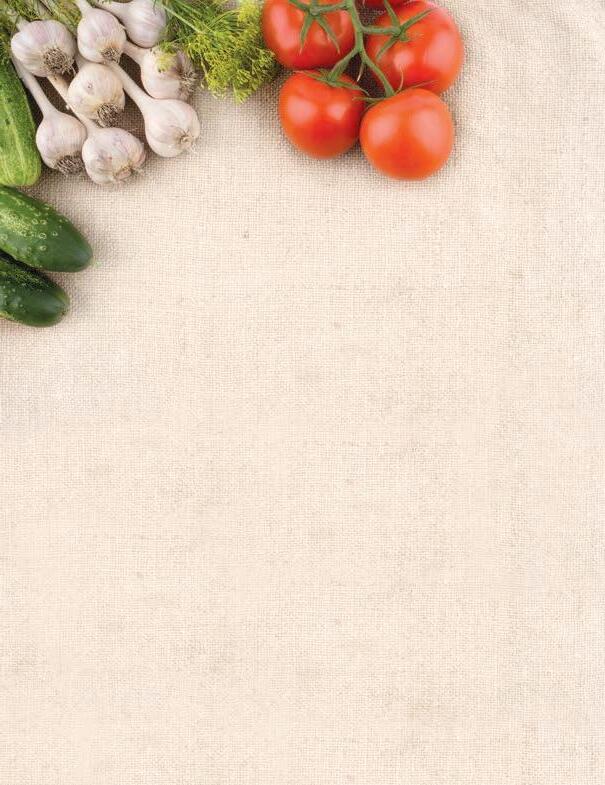
When you walk the grounds of Quinta Mazatlan in McAllen, you see the beauty of our native plants in small and large spaces around the urban sanctuary. Not only are they beautiful, but they also significantly help our wildlife in a time when a small percentage of native plants remain in the wild. The Granjeno (gran-hen-oh) is an example of a giving native plant from our region. The evergreen shrub will attract many birds to the sweet fruit in your garden. We find green jays, mockingbirds, cardinals and long-billed thrashers eat the tiny orange berries. The berry-bearing plant appreciates the birds and other animals spreading their seeds.
The Rio Grande Valley enjoys a number of different habitats with over 1,000 reported native species. There are plants found here that occur nowhere else in the United States. With plenty of sunshine but low rainfall, most of our native plants tend to have small leaves. A beautiful woody plant for your garden is the guayacán. It vaguely resembles the appearance of a northern evergreen and in the spring you’ll see violet flowers and fruit supporting the wildlife. There are also a number of native cacti that thrive in the region like pincushion cactus, Texas prickly pear and strawberry pitaya.
With such a large palette of native plants, Quinta Mazatlan selected 32 that gardeners can choose from to create tiny habitats at home. These native plants are featured in a beautiful poster designed by Brownsville artist Don Breeden, which is available in the Nature Store at Quinta Mazatlan. Some of the plants chosen were Texas lantana, lazy and cowpen daisy, cenizo, widow’s tears, silverleaf nightshade, Rio Grande phlox and tropical sage, just to name a few. Not only are these plants colorful and vibrant, some can be used in the kitchen too.

When creating your garden environment, include pieces of wood/ stumps for shelter and décor. Add water for the wildlife, even a simple shallow bowl or a water drip onto a rock. We each can provide homes for our wildlife by replicating forests on a small scale in our own little spaces. Remember that native plants can co-exist with what already
exists in your garden. Celebrate our regional beauty at home and help create a corridor of habitat to support our birds, butterflies and all living creatures.
Colleen Curran Hook is the manager of Quinta Mazatlan. She enjoys sharing her love of nature and encouraging families to get outdoors.
Quinta Mazatlan is an urban sanctuary in McAllen working to create places that build relationships between people and the natural world while benefiting all. The historic 1930s adobe mansion sits amid native gardens and a thorn forest with trails, birds, sculptures, history and room to play outdoors. Follow Quinta Mazatlan on social media or call 956-681-3370.
26 SPRING 2023 edible RIO GRANDE VALLEY
Some of the native plants found at Quinta Mazatlan are featured in a beautiful poster designed by Brownsville artist Don Breeden. Poster is available in the Nature Store at Quinta Mazatlan.
Market to Market
All Across the Rio Grande Valley Market Locations & Available CSAs
Wild August Nursery & Flower Market 16802 Garrett Rd.
October-May
Brownsville
Brownsville Farmers Market
Linear Park, 1495 E. 7th St.
Saturdays 9AM-12PM brownsvillewellnesscoalition.com
@brownsvillewellnesscoalition
The Market at North Park Plaza
800 N. Expressway 77/83
Saturdays 3-7PM
marketattheplaza.com
info@marketattheplaza.com
Edinburg
Hub of Prosperity Urban Farm
3707 W. University Dr.
Saturdays 9-11AM openfoodnetwork.net
@hub_of_prosperity
Harlingen
Harlingen Farmers Market
Tyler Avenue & 2nd St.
Saturdays 3-4:30PM
Mid October-mid June harlingenfarmersmarket.com
@harlingenfarmersmarket
HOPE Farmers Market
19833 Morris Rd.
Mondays & Thursdays-Saturdays 10AM-6PM yahwehfarm.com
yahwehs.farmgarden@gmail.com
@yahwehsfarm hopeforsfs@yahoo.com hopeforsfs.org
Saturdays 9AM-12PM
June-September
Fridays 6-9PM wildaugust.com
@themarketatwildaugust
Laguna Vista SPIGCC Community Farmers Market
South Padre Island Golf Course
1 Ocelot Trail Rd.
1st & 3rd Tuesday of the month 4:30-6:30PM
McAllen
Farm to Table Tres Lagos
Farmers Market
4350 Tres Lagos Blvd.
First Sunday of every month 2-5PM
visitmcallen.com
@treslagosmcallen
Grow’n Growers
Farmers Market
Firemen’s Park , 201 N. 1st St.
Saturdays 9AM-12PM visitmcallen.com
@farmersmarketatfiremenspark
McAllen Farmers Market 4001 N. 23rd St.
Saturdays 10AM-1PM mcallenfarmersmarket.com @mcallenfarmersmarket
Mission
Neighborhood Farmers Market
The Bryan House 1113 E. Mile 2 Rd.
Wednesdays 3-7PM thebryanhouse.com @thebryanhouse
Rancho Viejo
Rancho Viejo
Farmers Market
3301 Carmen Ave. Sundays 3-6PM ranchoviejofm.com @ranchoviejofarmersmarket
San Benito
El Pueblito Market
101 N. Reagan St.
Second Sunday of the month
11AM-3PM
elpuebilitomarket956@gmail.com
South Padre Island
South Padre Island
Farmers Market
8605 Padre Blvd.
Sundays 11AM-1PM sopadre.com
Weslaco
La Cebollita Mid-Valley Farmers Market
Weslaco City Hall
255 S. Kansas Ave.
Last Saturday of every month
11AM-2PM
@weslaco_chamber weslaco.com
Available CSAs in the RGV CSA, or Community Supported Agriculture (CSA), is one way consumers can directly support local farms. You connect directly with the farmer, and every week your farmer delivers or you can pick up a variety of fresh nutritious food. All CSAs have different financial structures and procedures, so we suggest you reach out to the CSA for more information.
CD&J Mini Ranch
Offers a produce CSA
Meat and egg CSA
29575 Adams Rd., San Benito cdjminiranch.com
@cdjminiranch_woman_owned
Nature’s Heartland Farm Offers produce and eggs
11920 N. Mile 16, Edinburg
Saturdays 10AM-4PM heartlandfarm.com
@naturesheartland
Sentli Center for Regenerative Agriculture
Offers a produce CSA

starting in November
Shakera Raygoza at (956) 472-7436
info@sentli.org
sentlifoods.localfood marketplace.com
Valley Green Growers Cooperative (VGG)
Offers fresh produce and protein boxes CSA
19833 Morris Rd., Harlingen vggcoop@hopeforsfs.org
MARKET GUIDE
Need an Easy Yummy Recipe?
 PHOTOS BY DANIELA LOERA
PHOTOS BY DANIELA LOERA
RECIPES 28 SPRING 2023 edible RIO GRANDE VALLEY
Minestrone Soup
Recipe by Rose and Jeff Gowen, owners of The Quilted Carrot, Brownsville Serves 6–8 depending on bowl size
“This is one of our favorite soups because the flavors are rich and we can make it to fit the day … add a bit more pepper flakes for a spicy day, add zucchini when in season, change the pasta and change the look! It is easy to cook, makes your kitchen say ‘mmmmm,’ and it’s vegan healthy too.”
1 small yellow onion, diced
2 stalks celery, thinly sliced
4 cloves garlic, minced
1 cup (128 grams) carrots, diced into ½-inch pieces
2–3 Yukon gold potatoes, diced into ½-inch pieces
2 cups (200 grams) green beans, cut into
1-inch pieces
1 cup (164 grams) corn kernels
2 teaspoons (10 milliliters) olive oil
1½ teaspoons (9 grams) salt
1 teaspoon (1.8 grams) dried thyme
1 teaspoon (1.8 grams) dried basil
1½ teaspoons (2.8 grams) dried rosemary
½ teaspoon (1 gram) red pepper flakes
1 teaspoon (5 milliliters) agave nectar
6 cups (1.5 liters) vegetable broth (adjust amount depending on how much broth you want)
1 cup (100 grams) uncooked macaroni or similar pasta
1 cup (177 grams) beans, canned, rinsed, drained or you can cook your own
1 28-ounce (794-gram) can crushed tomatoes
In a 4-quart (4-liter) soup pot on medium heat, sauté the onion and celery in the oil with a dash of salt until soft. This takes about 5 minutes.
Add the garlic and cook a few seconds. You should begin to smell the garlic and onion. This takes about 30 seconds.
Add the vegetable broth, red pepper flakes, thyme, rosemary, basil, remaining salt, potatoes and carrots. Cover pot and bring to a boil. Then lower the heat to simmer and add the green beans, the other beans and pasta. Simmer for about 10 minutes until the pasta and vegetables soften.
Add the tomatoes and agave and bring back up to a boil. Then lower the heat and simmer for 10 minutes. Turn off the heat and let soup sit for 10 minutes or so before serving.
Tips: Garnish with vegan cheese or Parmesan. If you enjoy more broth, add chicken broth when reheating. Serve with toasted baguette.
Note: For the beans, you may use navy beans, kidney beans or butter beans. For the macaroni, you may substitute a similar pasta like shells or your favorite. You may also use zucchini for variety and may even throw in a small amount of kale if you like.
edibleriograndevalley.com 29
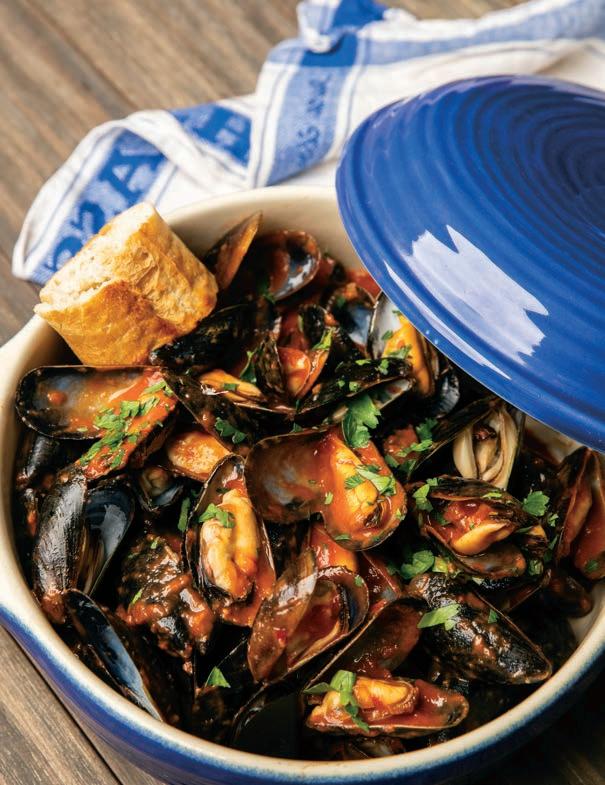
30 SPRING 2023 edible RIO GRANDE VALLEY
Mussels a la Española
Recipe by Ana Pau Lopez Serves 4
“A classical dish from Spain. It pairs nicely with a cold beer on a Sunday afternoon. Enjoy!”
1 package mussels, cleaned and de-bearded
1 onion, diced in small pieces
2 cloves garlic, diced in small pieces
½ cup (118.5 milliliters) red wine
1 cup (236.6 milliliters) water
½ cup (118.5 milliliters) juice from the mussels, obtained during steaming process
1 tablespoon (7.8 grams) flour
1 cup (236.6 milliliters) tomato sauce
1 tablespoon (14.8 milliliters) extra virgin
olive oil
½ teaspoon (2.3 grams) paprika
2 jalapeños, diced into small pieces (optional)
1 tablespoon (14.1 grams) chorizo paste (optional) (I like Nduja brand) Flatleaf parsley, for garnish
To clean the mussels:
Place the mussels in a colander in the sink, run cold water. Using a clean scrubbing brush, and taking one mussel at a time, place under the water and scrub off any debris like seaweed, sand, barnacles or mud that could be on the shell.
To de-beard the mussels:
The “beard” is a clump of hair-like fibers that protrude from the side of the shell.
To remove the beard, grab it with your thumb and forefinger and tug it toward the hinge of the mussel shell. You may also use a knife to gently scrape away the beard.
If you find any mussels with a broken shell, discard them. If a mussel is open along the lips, lightly tap it shut. If the mussel closes again in response, it is alive. If it does not close in response, discard it.
To steam the mussels:
In a double boiler: Add 1 cup of water to a pot and bring it to a boil. Place a second, slightly larger pot on top of the one containing the water, creating a double boiler. Place the mussels inside the top pot and cover. Cook until the mussels open. Once cooked, drain out the juice and set aside.
In a pan: Place 1 tablespoon of olive oil in the pan. Add the mussels, cover the pan and cook until the mussels open. Once cooked, drain out the juice and set aside.
To make the sauce:
In the olive oil, sauté the onion, garlic and jalapeños on medium heat. Add salt and pepper. Cook until onions are translucent, about 10 minutes. Add flour to the mixture. Cook on medium to low heat for 3 minutes, stirring constantly as flour can burn easily.
Add the tomato sauce, paprika and chorizo paste. Bring to a simmer. If the tomato paste tastes too acidic, add a teaspoon of sugar. Cook on low medium heat for 5 minutes.
Add the wine and increase temperature to medium high heat to allow the alcohol to evaporate. Cook for about 7 minutes. Once evaporated, add the juice from the mussels.
Using a hand blender, blend the sauce into a smooth consistency.
To serve, heat and plate the sauce. Place open mussels on top and garnish with flat leaf parsley. Enjoy with a toasted baguette.
Note: This recipe can be made ahead of time and served right before your dinner party.
edibleriograndevalley.com 31
Photo by Daniela Loera
Spicy Spring Smash
Recipe by Daniel Hunter-Holly | Photos by Daniela Loera Makes 1 serving
“The Spicy Spring Smash is easy to make, and the best part is that it is extremely flexible; you can use a variety of seasonal fruit, such as strawberries, pineapple, mangoes, or even passion fruit. Even the base spirit can be swapped!
“Great cocktails celebrate craftsmanship, from the extraordinary amount of care that goes into growing the ingredients for different liqueurs to the history and tradition of the distillation process, to the alchemy of combining the ingredients in just the right way.”
2 thin slices fresh ginger, ⅛-inch thick
2–3 strawberries, quartered
1 teaspoon (5 grams) extra fine granulated sugar
1½ ounces (44 milliliters) white rum
½ ounce (14.7 milliliters) Ancho Reyes Verde Chile Poblano Liqueur*

½ ounce (14.7 milliliters) triple sec like Grand Marnier
¾ ounce (22.2 milliliters) fresh lime juice
Sprig of basil or mint, for garnish
Muddle the ginger, strawberries and sugar in a mixing glass.
Add the rum, liqueurs and juice and shake with crushed ice.
Pour into a rocks glass without straining and add the garnish.

*Ancho Reyes Verde is the primary ingredient that makes the drink spicy. You can substitute by adding a slice of jalapeño to the rum and letting it infuse for a few minutes before straining and continuing with the recipe. Just be aware that fresh chiles can be inconsistently spicy.
For the pineapple and mango cocktails recipes see our website www.ediblergv.com
32 SPRING 2023 edible RIO GRANDE VALLEY
LAST SIP











































































SPRING 2023 edible RIO GRANDE VALLEY Subscribe to our newsletter! Delivered to your inbox every other Saturday morning and filled with authentic stories and inspired recipes from Edible magazines across the U.S. and Canada. Join us as we celebrate local foods season by season! Get Social! Follow us by scanning the QR code above. edible brooklyn ISSUE T H E Drinks Celebrating the Abundance Local Foods, Season Season edible Cape Cod edible manhattan The future of food MILK & HONEY the land ~ the sea ~ the people ~ the food edible M aritimes














































































 PHOTOS BY DANIELA LOERA
PHOTOS BY DANIELA LOERA















































































